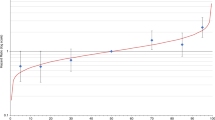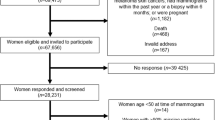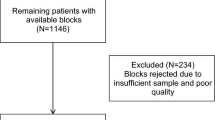Abstract
We used data from 765 cases and 564 controls in the population-based Australian Breast Cancer Family Study to investigate whether, in women under the age of 40, the profile of risk factors differed between breast cancer subtypes defined by joint oestrogen and progesterone receptor status. As hypothesised, no significant differences were found.
Similar content being viewed by others
Main
It has been postulated that joint oestrogen (ER) and progesterone receptor (PR) status might define aetiologically distinct subtypes of breast cancer (Potter et al, 1995). The ER+PR+ subtype predominates in western countries (64–68% in postmenopausal women) (Thorpe, 1988; Potter et al, 1995), but is less common in Japanese women (29%) (Nomura et al, 1992). Neoplasms in women with a germline BRCA1 mutation tend to be ER− (Phillips, 2000). The pattern of age-specific incidence rates, according to the joint ER/PR status, was similar in Danish women up to the age of 43 years, but differed distinctly thereafter (Yasui and Potter, 1999). This suggests that, if hormone receptor status is related to aetiology, such a relationship may be restricted to older women and not be evident in those under the age of 40 years.
Of published reports on ER or PR status and breast cancer risk, only three were population-based studies that examined differences in risk factor profile for the breast cancer subtypes ER+PR+, ER+PR−, ER−PR+, and ER−PR−. One was restricted to postmenopausal women (Potter et al, 1995), a second, predominantly to women over the age of 40 years (Huang et al, 2000), and the third to women aged 20–44 years (Britton et al, 2002). We used data from the Australian Breast Cancer Family Study (ABCFS), a population-based case–control–family study comprising women with breast cancer diagnosed before the age of 40 years and controls, to investigate whether, in that age group, the profile of risk factors differed between breast cancer subtypes defined by joint ER/PR status. Based on the findings in Danish women (Yasui and Potter, 1999), we hypothesised that there would be no difference in this age group.
Material and methods
The study was carried out in Melbourne, Victoria, and Sydney, New South Wales, during 1992–1999 (Hopper et al, 1994, 1999; McCredie et al, 1998). All participants provided written informed consent prior to participation in the study, which was approved by the human research ethics committees of the University of Melbourne and the Cancer Councils of Victoria and New South Wales.
Cases were identified from the population-based Victorian and New South Wales cancer registries (to which notification of all cancer diagnoses is mandatory), and comprised all women living in the metropolitan areas of Melbourne and Sydney who were aged less than 40 years at the diagnosis of a histologically confirmed first primary cancer of the breast (ICD-9 174). Recruitment began with a letter to the attending doctor, requesting permission to approach the woman. If permission was granted, a letter to the woman sought her participation. Of 1208 eligible cases, 856 (71%) agreed to participate. Reasons for nonparticipation included: death (2% of total eligible); refusal by the attending doctor (8%) or the woman (14%); nonresponse by the attending doctor (1%) or the woman (1%); and the woman having moved and unable to be located (3%).
Potential controls were women aged less than 40 years and living in the metropolitan areas of Melbourne and Sydney, who were selected from the electoral roll (to which adult registration is compulsory in Australia) using proportional random sampling based on the expected age distribution of the cases. Of 913 eligible controls, 600 (66%) agreed to participate, 27% refused and 8% did not respond.
Participation by cases and controls included a face-to-face interview in the subject's home. The two questionnaires covered: (a) demographic and ethnic background; height; weight; medical history; reproductive factors; and use of oral contraceptives, hormone replacement therapy, tobacco, and alcohol and (b) family history of breast and other cancers. In the period 1992–1995, participation was restricted to cases and controls who could speak English, while in the period 1996–1999 non-English speakers were also included.
We obtained both ER and PR status of the tumour for 694 (81%) participating cases (92% of women diagnosed in 1996–1999; 72% of those diagnosed in 1992–1995) – 87 through immunohistochemical testing (described in Armes et al, 1999) of tumour tissue held by the ABCFS, 405 from the histopathology report held at the cancer registry, and 202 through a written request to the pathology laboratory that issued the diagnostic histopathology report. ER/PR status was determined using methods that were immunohistochemical (64%), biochemical (34%) or unknown (2%).
For homogeneity, women known to have a deleterious germline mutation in either BRCA1 or BRCA2 were excluded. Germline testing has to date identified 42 cases with a deleterious mutation in either BRCA1 or BRCA2; a full description of the methods and extent of mutation testing can be found in Dite et al (2003).
For ease of interpretation, women of ‘Asian descent’ were excluded, as they differ from ‘western’ women not only with respect to their pattern of ER/PR subtypes (see above) but also in the magnitude of their risk of breast cancer. ‘Asian descent’ was defined as having any grandparent with a southeast Asian ethnic background (those reported here were Chinese, Japanese, Malaysian, Vietnamese, Korean, Filipino and Thai); 50 cases and 36 controls were of ‘Asian descent’. One case of ‘Asian descent’ carried a mutation. Thus, 765 cases (618 with known ER/PR status) and 564 controls were used in the analyses below.
Statistical analysis
Polytomous logistic regression models were used to estimate breast cancer risk in five groups defined by ER/PR status (ER+PR+, ER+PR−, ER−PR+, ER−PR−, and either ER or PR unknown) in relation to the following known or suspected risk factors: family history of breast cancer reported in a first-degree relative (no, yes); height (<163 cm, ⩾163 cm); body mass index (BMI; <23, ⩾23; 1 year before diagnosis (cases) or interview (controls)); age at menarche (<13 years, ⩾13 years); parous (no, yes); number of live births (0, 1, 2, ⩾3); age at first live birth (<25 years, ⩾25 years, for parous women only); and whether oral contraceptives had ever been used (no, yes). Cut-points were chosen to be consistent with Potter et al (1995) if feasible or, when this resulted in markedly uneven groups, were based on the distribution in controls. Differences in proportions, means and odds ratios were evaluated by unconditional logistic regression, analysis of variance, and the likelihood ratio test, respectively, using STATA software.
Results
The mean age at diagnosis of the 765 cases was 34.9 years (s.d. 3.6), with no difference in age between the five groups defined by ER/PR status (P=0.3). Among the 564 controls, the mean age at recruitment was 33.7 years (s.d. 4.4). Cases with known and unknown ER/PR status were similar with respect to educational level (P=0.4), marital status (P=0.5), and whether or not they had been born in Australia (P=0.1).
Among the 618 tumours with known ER/PR status, the distribution of ER/PR subtypes was 53% ER+PR+, 6% ER+PR−, 13% ER−PR+, and 29% ER−PR−, and there was no difference in this distribution between tumours diagnosed in 1992–1995 and those diagnosed in 1996–1999 (P=0.1).
Table 1 gives the proportion of women by risk factor in each ER/PR-defined group, and shows that the odds ratios for breast cancer according to risk factor did not differ between the ER/PR subtypes (0.2<P<0.9). The inclusion of women of ‘Asian descent’, and/or those with a BRCA1 or BRCA2 mutation, and the exclusion of women with unknown ER/PR status, made essentially no difference to this finding.
Discussion
As hypothesised, this population-based study in non-Asian Australian women under the age of 40 years found, with or without excluding cases known to carry a germline mutation in BRCA1 or BRCA2, no evidence that the effects of any of the major established risk factors differ for breast cancers defined by joint ER and PR status. This lack of heterogeneity in disease in young women accords with the analysis of Yasui and Potter (1999), who applied the age-specific distribution of ER/PR subtypes seen in tumours of 3359 cases (of all ages) in the Danish Breast Cancer Cooperative Group to the national Danish age-specific breast cancer incidence rates (age was the only risk factor examined in their analysis).
The Danish data support the suggestion that ER/PR receptor status might define aetiologically distinct subtypes of breast cancer in older women. While two other population-based studies of breast cancer have claimed evidence for some differences in risk factor profile according to joint ER/PR receptor status (Potter et al, 1995; Huang et al, 2000), they should perhaps be viewed as hypothesis-generating analyses, given that their findings were based on multiple comparisons, had nominal P-values of marginal significance, and some comparisons lacked statements about the statistical significance of observed differences in odds ratios. A third study, of early onset disease, found, as we did, no clear support for aetiologically distinct subtypes (Britton et al, 2002). Neither BRCA1 or BRCA2 mutation carriers nor women of Asian descent had been excluded from these studies.
Our null finding must be tempered by considerations of statistical power – we could have missed modest differences in risk factor profiles. Each of the previous studies (Potter et al, 1995; Huang et al, 2000; Britton et al, 2002) had similarly limited power. To resolve these issues, there is a need for bigger or combined studies with careful consideration of age at diagnosis, ethnic background, and the status of deleterious germline mutations in known susceptibility genes.
Change history
16 November 2011
This paper was modified 12 months after initial publication to switch to Creative Commons licence terms, as noted at publication
References
Armes JE, Trute L, White D, Southey MC, Hammet F, Tesoriero A, Hutchins A-M, Dite GS, McCredie MRE, Giles GG, Hopper JL, Venter DJ (1999) Distinct molecular pathogeneses of early-onset breast cancers in BRCA1 and BRCA2 mutation carriers: a population-based study. Cancer Res 59: 2011–2017
Britton JA, Gammon MD, Schoenberg JB, Stanford JL, Coates RJ, Swanson GA, Potischman N, Malone KE, Brogan DJ, Daling JR, Brinton LA (2002) Risk of breast cancer classified by joint estrogen receptor and progesterone receptor status among women 20–44 years of age. Am J Epidemiol 156: 507–516
Dite GS, Jenkins MA, Hocking JS, Giles GG, McCredie MRE, Southey MC, Venter DJ, Hopper JL (2003) Familial risks, early-onset breast cancer, and BRCA1 and BRCA2 germline mutations. J Natl Cancer Inst 95: 448–457
Hopper JL, Chenevix-Trench G, Jolley D, Dite GS, Jenkins MA, Venter DJ, McCredie MRE, Giles GG (1999) Design and analysis issues in a population-based case–control–family study of the genetic epidemiology of breast cancer, and the Co-operative Family Registry for Breast Cancer Families (CFRBCS). Monogr Natl Cancer Inst 26: 95–100
Hopper JL, Giles GG, McCredie MRE, Boyle P (1994) Background, rationale and protocol for a case–control–family study of breast cancer. The Breast 3: 79–86
Huang W-Y, Newman B, Millikan RC, Schnell MJ, Hulka BS, Moorman PG (2000) Hormone-related factors and risk of breast cancer in relation to estrogen receptor and progesterone receptor status. Am J Epidemiol 151: 703–714
McCredie MRE, Dite GS, Giles GG, Hopper JL (1998) Breast cancer in Australian women under the age of 40. Cancer Causes Control 9: 189–198
Nomura Y, Miura S, Koyama H, Enomoto K, Kasumi F, Yamamoto H, Kimura M, Tominaga T, Iino H, Morimoto T, Tashiro H (1992) Relative effect of steroid hormone receptors on the prognosis of patients with operable breast cancer. Cancer 69: 153–164
Phillips KA (2000) Immunophenotypic and pathologic differences between BRCA1 and BRCA2 hereditary breast cancers. J Clin Oncol 18(21 Suppl): S107–S112
Potter JD, Cerhan JR, Sellers TA, McGovern PG, Drinkard C, Kushi LR, Folsom AR (1995) Progesterone and estrogen receptors and mammary neoplasia in the Iowa Women's Health Study: how many kinds of breast cancer are there? Cancer Epidemiol Biomarkers Prev 4: 319–326
Thorpe S.M (1988) Estrogen and progesterone receptor determinations in breast cancer. Acta Oncol 27: 1–19
Yasui Y, Potter JD (1999) The shape of age-incidence curves of female breast cancer by hormone-receptor status. Cancer Causes Control 10: 431–437
Acknowledgements
The Australian Breast Cancer Family Study was supported by the National Health and Medical Research Council of Australia, the New South Wales Cancer Council, the Victorian Health Promotion Foundation and the United States National Cancer Institute, National Institutes of Health under RFA #CA-95-003 as part of the Breast Cancer Family Registries (CFRs), and through cooperative agreements with the Fox Chase Cancer Center, Huntsman Cancer Institute, Columbia University, Northern California Cancer Center, Cancer Care Ontario, and The University of Melbourne. The content of this manuscript does not necessarily reflect the views or policies of the National Cancer Institute or any of collaborating centres in the Breast CFRs, nor does it mention of trade names, commercial products, or organisations imply endorsement by the US Government or the CFRs. MMcC was supported in New Zealand by the Inkster Ross Memorial Fund of the University of Otago. We acknowledge the help of Maggie Angelakos and Simon Royce.
Author information
Authors and Affiliations
Corresponding author
Rights and permissions
From twelve months after its original publication, this work is licensed under the Creative Commons Attribution-NonCommercial-Share Alike 3.0 Unported License. To view a copy of this license, visit http://creativecommons.org/licenses/by-nc-sa/3.0/
About this article
Cite this article
McCredie, M., Dite, G., Southey, M. et al. Risk factors for breast cancer in young women by oestrogen receptor and progesterone receptor status. Br J Cancer 89, 1661–1663 (2003). https://doi.org/10.1038/sj.bjc.6601293
Received:
Revised:
Accepted:
Published:
Issue Date:
DOI: https://doi.org/10.1038/sj.bjc.6601293
Keywords
This article is cited by
-
Oncobiology and treatment of breast cancer in young women
Cancer and Metastasis Reviews (2022)
-
A prospective investigation of oral contraceptive use and breast cancer mortality: findings from the Swedish women’s lifestyle and health cohort
BMC Cancer (2019)
-
Pregnancy-associated breast cancer in women from Shanghai: risk and prognosis
Breast Cancer Research and Treatment (2015)
-
Family history of breast and ovarian cancer and triple negative subtype in hispanic/latina women
SpringerPlus (2014)
-
Reproductive risk factors and oestrogen/progesterone receptor-negative breast cancer in the Breast Cancer Family Registry
British Journal of Cancer (2014)



